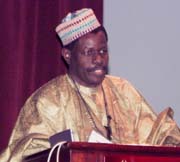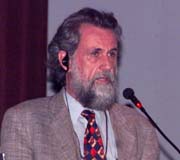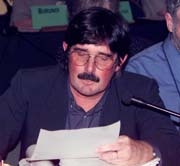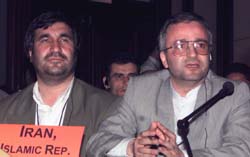 |
San José, Costa Rica 10-18 May 1999 |
|
Briefing |
|
Delegates at COP7
met in Plenary to hear overviews of implementation of the Convention in
Africa, Eastern and Western Europe, the Neotropics and North America,
as well as a number of special presentations. They convened for an additional
evening session to consider a draft resolution on regional categorization
of countries. IN THE CORRIDORS
|
|
|
|
Tim
Jones, Regional Coordinator for Europe, presented the regional overview
of implementation in Western and Eastern Europe. He highlighted achievements
in implementing the wise use guidelines in the region, including: wide
application of environmental impact assessment; high priority assigned
to restoration; and significant progress in implementing wetland policies
and establishing national committees.
|
 |
| Anada Tiega, Regional Coordinator for Africa, presented an overview of implementation of the Convention and the Strategic Plan for 1997-2002 in Africa. He stressed that wise use and communications are inseparable, and underscored the use of inventories as a basis for decision making. He identified the major threats to wetlands as inappropriate land-use practices, the increased prevalence of invasive species and pollution. | |
|
Bill
Phillips, Deputy Secretary-General of the Convention, presented progress
in implementing the Convention in the North American region, including,
inter alia: a wide range of EIA and wetland-related policy instruments;
integrated and watershed approaches; experimentation with assessments
and economic valuation of wetlands; wetland restoration initiatives; institutional
capacities and cooperation; bilateral agreements on migratory birds; and
donor assistance for wetlands projects.)
|
 |
| Geoffrey Howard, Programme Coordinator, IUCN East Africa, made a presentation on invasive species. He outlined their effects on wetlands and other water-dependent ecosystems, including: alteration of flow, water quality and downstream wetland functions; reduction of water quantity; alterations in fisheries; increase in human health hazards; reduction in wetland species abundance and diversity; and alteration of wetland species population integrity, community structure and distribution. | |
|
Nestor Windevoxhel, COP7 Special Advisor, presented an overview of Convention
implementation in the Neotropical region. He said the main achievements
since COP6 include increased attention to the conservation and rehabilitation
of degraded wetlands, actions to enhance EPA, and development of management
plans for one-third of the Neotropical Ramsar sites.
|
 |
| URUGUAY, on behalf of the Neotropical region, proposed that the Standing Committee include an additional alternate representative from their region, and that the SC’s composition be determined not only by the quantitative criterion of the number of CPs per region but also by qualitative criteria. | |
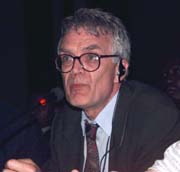 |
|
| IRAN proposed establishing an open-ended working group to resolve the regional categorization issue. | |
|
ISRAEL
instead called for a vote on the two categorization options.
|
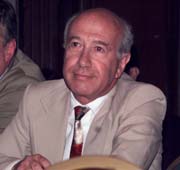 |
Back to ENB's Ramsar COP7 home page
© Earth Negotiations Bulletin, 1999. All rights reserved.

